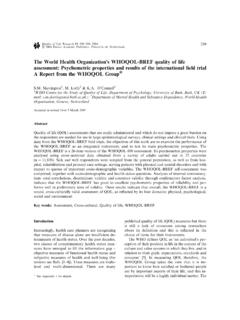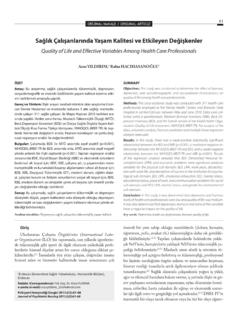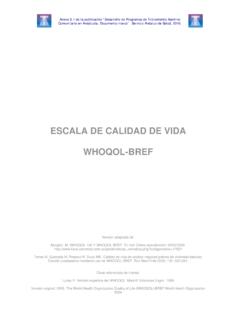Transcription of WHOQOL-BREF INTRODUCTION, …
1 WHOQOL-BREFINTRODUCTION, ADMINISTRATION, SCORINGAND GENERIC VERSION OF THE ASSESSMENTF ield Trial VersionDecember 1996 PROGRAMME ON MENTAL HEALTHWORLD HEALTH ORGANIZATIONGENEVAThis manual was drafted by Alison Harper on behalf of the WHOQOL group. TheWHOQOL group comprises a coordinating group, collaborating investigators in each of the fieldcentres and a panel of consultants. Dr J. Orley directs the project. He has been assisted in thisby Professor M. Power, Dr W. Kuyken, Professor N. Sartorius, Dr M. Bullinger and Dr The field centres involved in initial piloting of the WHOQOL were: Professor , Dr H. Schofield and Ms B. Murphy, University of Melbourne, Australia; Professor , Professor S. Szabo and Mrs M. Pibernik-Okanovic, Institute of Diabetes, Endocrinology and Metabolic Diseases and Department of Psychology, Faculty of Philosophy,University of Zagreb, Croatia; Dr N. Quemada and Dr A. Caria, INSERM, Paris, France; Dr and Mrs Shuba Kumar, Madras Medical College, India; Dr S.
2 Saxena and Dr , All India Institute of Medical Sciences, New Delhi, India; Dr M. Amir and Dr , Ben-Gurion University of the Negev, Beer-Sheeva, Israel; Dr Miyako Tazaki,Department of Science, Science University of Tokyo, Japan and Dr Ariko Noji, Department ofCommunity Health Nursing, St Luke's College of Nursing, Japan; Dr G. van Heck and Mrs J. DeVries, Tilburg University, The Netherlands; Professor J. Arroyo Sucre and Professor L. Picard-Ami, University of Panama, Panama; Professor M. Kabanov, Dr A. Lomachenkov and Dr , Bekhterev Psychoneurological Research Institute, St. Petersburg, Russia; Dr Carrasco, University of Barcelona, Spain; Dr Yooth Bodharamik and Mr KitikornMeesapya, Institute of Mental Health, Bangkok, Thailand; Dr S. Skevington, University of Bath,United Kingdom; Professor D. Patrick, Ms M. Martinand, Ms D. Wild, University ofWashington, Seattle, USA and; Professor W. Acuda and Dr J. Mutambirwa, University ofZimbabwe, Harare, Zimbabwe.
3 New centres using the field version of the WHOQOL-100 are: Dr S. Bonicato,FUNDONAR, Fundacion Oncologica Argentina, Argentina; Dr Molzahn, University ofVictoria, Canada; Dr G. Yongping, St Vincent s Hospital, Victoria, Australia; Dr G. Page,University of Quebec at Rimouski, Canada; Professor J. Fang, Sun Yat-Sen University ofMedical Sciences, People s Republic of China; Dr M. Fleck, University of the State of RioGrande do Sul, Brazil; Professor Angermeyer, Dr R. Kilian, Universit tsklinikum Klinikund Poliklinik f r Psychiatrie, Leipzig, Germany; Mr Kwok Fai Leung, Hospital Authority,Hong Kong; Dr Hanestad, University of Bergen, Norway; Dr Mubbashar,Rawalpindi General Hospital, Pakistan; Dr J. Harangozo, Semelweis University of Medicine,Budapest & Dr L. Kullman, National Institute of Mental Rehabilitation, Budapest, Hungary; Professor I. Wiklund, Health Economics & quality of life , Astra H ssle AB, Sweden; Dr , Dr Beh et Uz Paediatric Hospital, Bal ova/Izmir, Turkey; Dr G.
4 De Girolamo, ServizioSalute Mentale USL 27, Italy; Professor P. Bech, Frederiksborg General Hospital, Denmark; Pippalla, Howard University, College of Pharmacy and Pharmaceutical Sciences,Washington, DC, USA and Dr H. Che Ismail, School of Medical Sciences, Kelantan, information can be obtained from:Dr John OrleyProgramme on Mental HealthWorld Health OrganizationCH-1211 Geneva 27, SwitzerlandThis document is not issued to the general public, and all rights are reserved by the WorldHealth Organization (WHO). This document may not be reviewed, abstracted, quoted,reproduced, translated, referred to in bibliographical matter or cited, in part or in whole,without the prior written permission of WHO. No part of this document may be stored in aretrieval system or transmitted in any form by any means - electronic, mechanical or other -without the prior written permission of WHO. The WHOQOL Group, Programme on MentalHealth, WHO, CH-1211 Geneva 27, - INSTRUCTIONSPage 4 WHOQOL-BREFWHOQOL-BREFWHOQOL-BREFWHOQOL- BREFI ntroduction, Administration, Scoring andIntroduction, Administration, Scoring andIntroduction, Administration, Scoring andIntroduction, Administration, Scoring andGeneric Version of the AssessmentGeneric Version of the AssessmentGeneric Version of the AssessmentGeneric Version of the AssessmentIntroductionThe WHOQOL-100 quality of life assessment was developed by the WHOQOL Group withfifteen international field centres, simultaneously, in an attempt to develop a quality of life assessment thatwould be applicable cross-culturally.
5 The development of the WHOQOL-100, has been detailed elsewhere ( Orley & Kuyken, 1994; Szabo, 1996; WHOQOL Group 1994a, 1994b, 1995). Thisdocument gives a conceptual background to the WHOQOL definition of quality of life and describes thedevelopment of the WHOQOL-BREF , an abbreviated version of the WHOQOL-100. It also includes ageneric English language version of the WHOQOL-BREF , instructions for administering and scoring, andproposed uses for this short form of the for the development of the WHOQOL-100 WHO's initiative to develop a quality of life assessment arose for a number of reasons. In recentyears there has been a broadening in focus in the measurement of health, beyond traditional healthindicators such as mortality and morbidity ( World Bank, 1993; WHO, 1991), to include measures ofthe impact of disease and impairment on daily activities and behaviour ( Sickness Impact Profile;Bergner, Bobbitt, Carter et al, 1981), perceived health measures ( Nottingham Health Profile; Hunt,McKenna and McEwan, 1989) and disability / functional status measures ( the MOS SF-36, Ware etal, 1993).
6 These measures, whilst beginning to provide a measure of the impact of disease, do not assessquality of life per se, which has been aptly described as "the missing measurement in health" (Fallowfield,1990). Second, most measures of health status have been developed in North America and the UK, andthe translation of these measures for use in other settings is time-consuming, and unsatisfactory for anumber of reasons (Sartorius and Kuyken, 1994; Kuyken, Orley, Hudelson and Sartorius, 1994). Third,the increasingly mechanistic model of medicine, concerned only with the eradication of disease andsymptoms, reinforces the need for the introduction of a humanistic element into health care. By callingfor quality of life assessments in health care, attention is focused on this aspect of health, and resultinginterventions will pay increased attention to this aspect of patients' well-being. WHO's initiative to developa quality of life assessment arises from a need for a genuinely international measure of quality of life anda commitment to the continued promotion of an holistic approach to health and health in the development of the WHOQOL-100 The WHOQOL-100 development process consisted of several stages.
7 These are explained in briefwithin this document. For a detailed description, the reader is referred to the WHOQOL Group (1994a,1994b, in preparation). In the first stage, concept clarification involved establishing an agreed upondefinition of quality of life and an approach to international quality of life of life is defined as individuals' perceptions of their position in life in the context of the culture andvalue systems in which they live and in relation to their goals, expectations, standards and definition reflects the view that quality of life refers to a subjective evaluation which isembedded in a cultural, social and environmental context. Because this definition of quality of life focusesupon respondents' "perceived" quality of life , it is not expected to provide a means of measuring in anyWHOQOL-BREF - INSTRUCTIONSPage 6detailed fashion symptoms, diseases or conditions, but rather the effects of disease and health interventionson quality of life .
8 As such, quality of life cannot be equated simply with the terms "health status", "lifestyle", " life satisfaction", "mental state" or "well-being". The recognition of the multi-dimensional natureof quality of life is reflected in the WHOQOL-100 the second stage of development, exploration of the quality of life construct within 15 culturallydiverse field centres was carried out to establish a list of areas/facets that participating centres consideredrelevant to the assessment of quality of life . This involved a series in meetings of focus groups whichincluded health professionals, patients and well subjects. A maximum of six specific items for exploringeach proposed facet were generated by each centreZs focus group. To enable the collaboration to begenuinely international the 15 field centres were selected world-wide to provide differences in level ofindustrialisation, available health services, and other markers relevant to the measurement of quality of life ( role of the family, perception of time, perception of self, dominant religion).
9 In the third stage of development, questions from each centre were assembled into a global pool. After clustering semantically equivalent questions, 236 items covering 29 facets were included in a finalassessment. Pilot work involved administration of this standardised assessment to at least 300 respondentswithin each field testing in these 15 centres, 100 items were selected for inclusion in theWHOQOL-100 Field Trial Version. These included four items for each of 24 facets of quality of life , andfour items relating to the [overall quality of life and general healthZ facet (see Table 1). The method bywhich these 100 items were selected is fully documented elsewhere (The WHOQOL Group, inpreparation). The WHOQOL-100 Field Trial Version is currently being tested in new centres world-wide(these centres are outlined on page 6 of this document). The initial conceptual framework for theWHOQOL-100 proposed that the 24 facets relating to quality of life should be grouped into 6 domains.]
10 Recent analysis of available data, using structural equation modelling, has shown a four domain solutionto be more appropriate. For a more detailed explanation of this, the reader is referred to The WHOQOLG roup (in preparation). The WHOQOL-BREF is therefore based on a four domain structure (see Table1).Table 1 - WHOQOL-BREF domainsDomainDomainDomainDomain Facets incorporated within domainsFacets incorporated within domainsFacets incorporated within domainsFacets incorporated within domains1. Physical healthActivities of daily livingDependence on medicinal substances and medical aidsEnergy and fatigueMobilityPain and discomfortSleep and restWork Capacity2. PsychologicalBodily image and appearanceNegative feelingsPositive feelingsSelf-esteemSpirituality / Religion / Personal beliefsThinking, learning, memory and concentration3. Social relationshipsPersonal relationshipsSocial supportSexual activity4. EnvironmentFinancial resourcesFreedom, physical safety and securityHealth and social care: accessibility and qualityHome environmentOpportunities for acquiring new information and skillsParticipation in and opportunities for recreation / leisure activitiesPhysical environment (pollution / noise / traffic / climate)TransportDevelopment of the WHOQOL-BREFThe WHOQOL-100 allows detailed assessment of each individual facet relating to quality of life .















